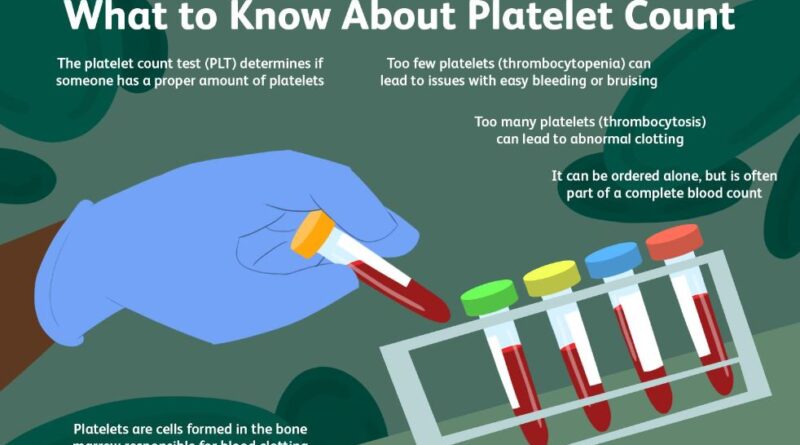Is Platelet Count Important: Diagnosis and Treatment?
After getting a cut or injury on your body, you must have seen a blood clot that appears. This blood clot happens because of the presence of platelets in your blood. The function of the platelets is to stop the bleeding that may occur due to ruptured blood vessels, and it acts as a glue to seal the opening. Platelets, also known as thrombocytes, gets produced in the bone marrow present in the bones of your body. Most importantly, every human must have a normal platelet count, and it is possible to determine this number through platelet tests done in medical laboratories.
Meaning of a Platelet Count Test
A medical laboratory like SRL diagnostics performs a test to measure the number of platelets or thrombocytes present in a microliter of blood by drawing a little of it out from your body. This test is known as a platelet count test and is necessary for a dengue test.
Types of Platelet Function Tests
A doctor may prescribe different platelet function tests like the following:
1) Platelet Aggregometry: A group of tests to measure the aggregation or clumping of platelets.
2) Flow Cytometry: Available in specialized laboratories, this is a test done using lasers to see for specific proteins in the platelets, which diagnoses any inherited platelet disorders.
3) Closure Time: This test checks the time a blood sample takes to close a tiny hole in a tube to determine any platelet disorders.
4) Viscoelastometry: A blood clot formed by platelets has to be strong, and this test checks this strength.
5) Lumi Aggregometry: This test adds specific substances to the blood sample to check any defects in the platelets by seeing the amount of light produced.
Diagnosis of Platelets through Platelet Tests
After you get a platelet count test done, three diagnosis scenarios may arise, and they are as follows:
1) Normal Platelet Level:
If you have a normal platelet count level, it means that the number of platelets per microliter of blood is within the range of 150000 to 450000.
2) Low Platelet Level:
When you have a platelet count of less than 150000, it is known as thrombocytopenia. It means that your blood does not clot easily, and you could develop the following symptoms:
- You may experience bleeding of the nose.
- A cut or an injury may bleed continuously.
- There may be the formation of purple patches under your skin called Purpura.
- Prolonged menstrual cycles may happen.
- Tiny red dots may appear on your skin, called Petechiae.
- You may even experience the outflow of blood in the urine or stool.
The causes for a low platelet count could be due to any of the following reasons:
- Attack by viruses can cause and show a low platelet count, like in the case of a dengue blood test, hepatitis or measles.
- Cancer treatments like chemotherapy and radiation can harm tissues and cells in the body, reducing the production of platelets.
- Autoimmune disorders can cause the immune system to attack certain tissues in the body, including blood platelets, like Crohn’s or Lupus disease.
- Bacterial infections like Sepsis can cause platelet levels to drop.
- Certain cancers of the bone marrow, like Lymphoma or Leukemia, can reduce platelet production in your body.
- Drinking in excessive quantities can cause liver cirrhosis which in turn can harm blood platelet production and count.
- The consumption of certain medicines, like certain antibiotics, can reduce the platelet count in the body.
3) High Platelet Levels:
A higher-than-normal platelet count of more than 450000 is also known as thrombocytosis. There are two types of it, namely, primary or essential thrombocytosis and secondary thrombocytosis. Both these types of thrombocytosis increase the production of platelets in the bone marrow, but the cause for the first one is unknown, and the second one may be because of any ongoing treatments or illnesses. The symptoms of having a high platelet count are as follows:
- You may get severe headaches.
- There may be feeling of weakness and dizziness.
- Spontaneous formations of blood clots in the hands and legs may happen.
- It is even possible to feel a sensation of numbness or burning in the toes, fingertips and hands.
Causes of having a high platelet count may be because of the following:
- A recent injury or surgery and the recovery process can cause more platelet production.
- Certain types of medicines can cause higher than normal platelet count.
- Any bacterial or viral infection in the body can increase the platelet levels in the blood.
- Some cancers, like breast or ovarian cancer, can cause blood platelet levels to rise.
Treatment of Platelet Count Levels
The primary purpose of conducting a platelet count test is to know whether the levels are higher than normal or lower. Then, based on the blood platelet count levels, a doctor can study the underlying cause of the changed levels. They can then suggest the appropriate treatment, which could be to control the platelet levels directly or to treat the disease causing the counts to increase or decrease.
Summary
The function of the blood platelets is critical for your body, and it protects you from any bruises, cuts or injuries that lead to bleeding. So, if you see any of the symptoms mentioned above, immediately get in touch with your physician and check that you have normal platelet count levels. And, if you notice any changes in the levels, get the proper treatment necessary to maintain an adequate platelet count.



